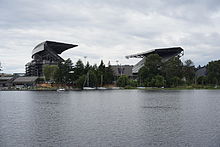Husky Stadium
[5] Its U-shaped design was specifically oriented (18.167° south of due east) to minimize glare from the early afternoon sun in the athletes' eyes.
On July 27, 1923, the stadium was the site of President Warren G. Harding's final public address;[9] he died in San Francisco six days later.
The Seattle fire department and emergency response teams rescued mock victims and buildings constructed on the field that were exploded as P-38 planes flew overhead to demonstrate how citizens should react.
The project made headlines on February 25, 1987, when the grandstand collapsed during construction as a result of miscommunication between the workers and the contractor, which led to the premature removal during the intended replacement of several support cables.
[15] Although there were no casualties, property damage ranged from $500,000 to $1 million and resulted in setbacks; however, the stadium addition was completed in time for the start of the 1987 Husky football season.
Husky Stadium was the temporary home of the Seattle Seahawks for five games (two preseason and three regular season) in 1994 while the Kingdome was temporarily closed for repairs to its damaged roof.
The project was funded by Seattle Seahawks owner Paul Allen, who used Husky Stadium as a temporary home venue during the construction of CenturyLink Field.
[21] In addition to the new playing surface, the Seahawks made other improvements to Husky stadium in preparation for its tenure as an NFL venue for two seasons.
Purple end zones returned prior to the 2010 season, and were temporarily painted black for the Huskies' first "blackout" game against UCLA on November 18.
[24] The games were previously rotated among three Pierce County high school venues after the WIAA elected to move them out of the Tacoma Dome in 2019 amid rising costs and impaired sight lines from the latter's 2018 renovations.
However, a fan named Omar Parker sitting on the open (east) end of the stadium at the student side started yelling "sideways".
Longtime UW band director Bill Bissell also claimed co-creator credit with Weller, suggesting that the wave was devised by both of them prior to the game.
[31] This is in part due to the stadium's design; almost 70% of the seats are located between the end zones, covered by cantilevered metal roofs that trap the sound.
[32] On occasion, the high decibel levels at Husky games along with fans stomping their feet in the bleachers cause television cameras to shake.
Husky Stadium had developed numerous structural problems over the years as a result of standing for nine decades in Seattle's moist weather, particularly in the lower bowl.
In November 2011, Husky Stadium began a $261 million renovation,[40] the largest single capital project in the university's history.
This major remodel of the athletic village coincided with construction for an underground station for a northern extension of the Link light rail system and a replacement of the Evergreen Point Floating Bridge.
The renovation project incorporated a new grand concourse, press box, video and audio system, and football offices, as well as new and improved amenities, concession stands, and bathrooms.
Husky Stadium was among several local venues considered as a potential temporary home for a Major League Soccer team in the mid-1990s.








